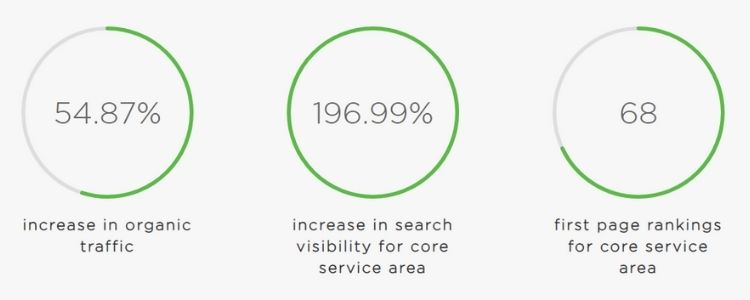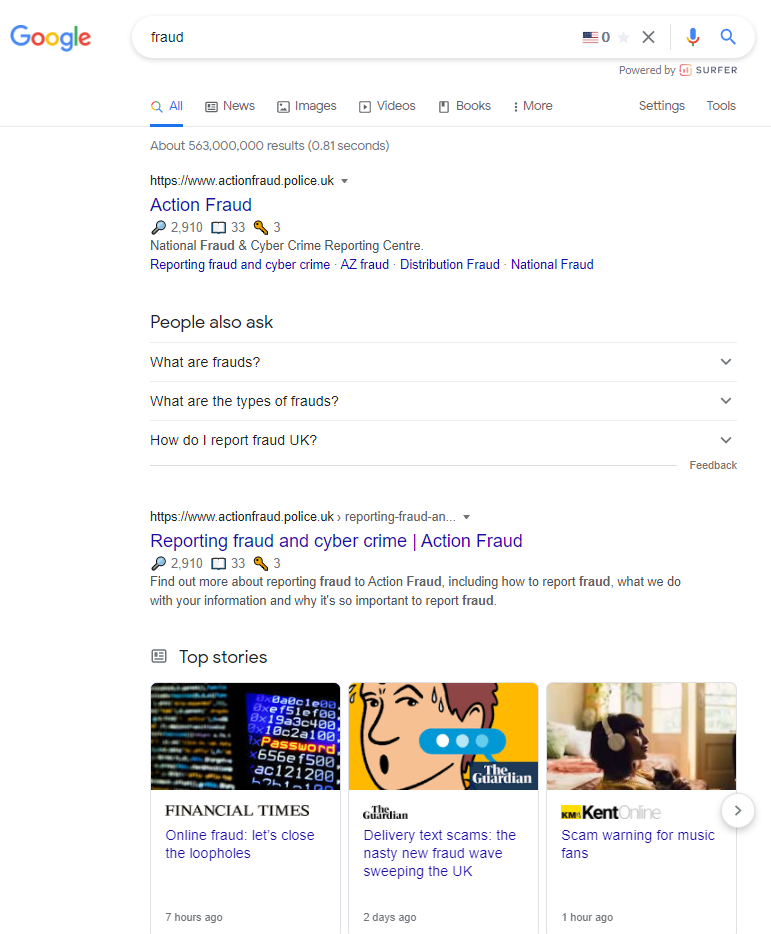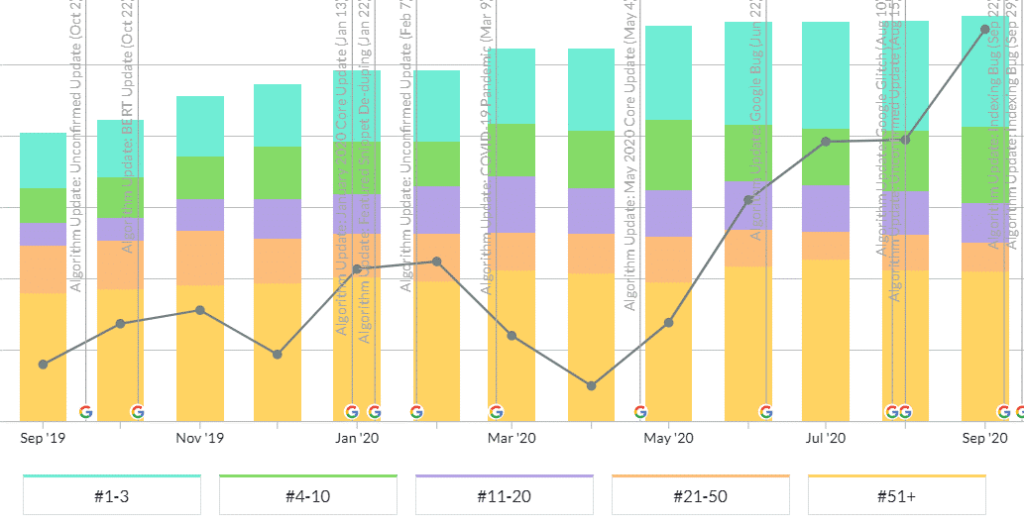For any business with an online presence, increasing search visibility and outranking your competitors are two pretty good goals to have. However, if you offer a large and varied range of products, or you specialize in a range of services, it can be difficult to know when and where to focus your attention.
That’s where targeted optimization comes in. In this blog post, we’re going to talk you through how to increase overall search visibility with this strategy which should help you attract the right customers, increase conversions, improve brand awareness and, crucially, use your time most efficiently.
We’ll take you through seven simple steps to improve your website visibility and explain it in the context of one of our most recent case studies so you can actually visualize what we’re talking about.
Essentially, we’ll explain how we achieved these results:

But first, let’s define our key terms:
Search Visibility: The percentage of clicks your website receives based on your organic rankings in the search engine results pages (SERPs).
Targeted Optimization: Optimizing your website’s content to target specific search terms that are relevant to your business and target audience.
7 steps to improve website visibility
Let’s take a look at the 7 steps you can take to improve your website visibility.
Step 1: Understand Your Business
The first and arguably the most vital step is to really understand your or your client’s business.
Are there particular services that they consider their specialism?
Are there particular products or services that they want to push at different times of year?
If you can establish a core area to focus your efforts, it will make your project more manageable and achievable.
After completing a successful site move for our client – a barristers chambers – we moved into more targeted optimization based on their chosen service areas. It’s common for barristers and solicitors to be flexible in terms of their core focus, and there are seasonal peaks for different legal services. In the early part of 2020, fraud was the legal area they requested as their focus.
Step 2: Content Audit
Once you’ve settled on an area of specialism to focus your efforts, you need to undertake a content audit to fully understand how much and what type of relevant content you have on your site.
We recommend creating a spreadsheet to keep track of your content so you can see at a glance what pages need attention and which topics need bulking out.
As part of your content audit, you should review the keywords you’re ranking for and the keywords you’re tracking. Ensure the intent of the search terms you’re ranking for align with the intent of your content, and keep an eye out for any pages that are ranking for the same keyword – ask yourself if this content would be better merged.
Review the keywords you’re tracking that relate to your focus area and assess if all of these terms are actually relevant to your business, industry, or service area. If you have doubts, plug the search term into Google and examine the top ranking pages in the SERP.
If you come across any search terms which you shouldn’t be targeting or tracking, cull them from your keyword tracking tool. This will ensure your keyword metrics are accurate and relevant.
For our client, refining our keyword list was a crucial first step. For example, we were tracking the term ‘fraud’ which, as you can see below, doesn’t pull up a SERP that a barristers chambers would naturally fit in to.
Similarly, our client’s target customers – clients needing legal assistance for fraud-related cases – are probably going to search for more focused terms, and these are the terms we’re interested in.

Step 3: Keyword Research
Now that you’ve done your content audit and reviewed your keywords, it’s time for some fresh keyword research. There are so many great tools for keyword research – our favorite is Google’s Keyword Planner which we use in conjunction with SEMRush and Mangools. These tools will help you to identify additional keywords and sub-topics that you can target.
When selecting your keywords, you need to make sure the search intent aligns with your business and the content you can create well. You also need to ensure your content could fit into the SERP query landscape. Essentially, does or can your content match what Google believes are the top search results for that query?
We also recommend paying attention to long-tail keywords. Targeting long-tail search terms can help you generate traffic to your website, especially if you’re a small business or have a weak online presence. The search volume of these terms is low, but search intent is more focused.
Hubspot defines long-tail keywords as:
“A keyword phrase that aims to capture search traffic from a specific, often 3+ word search query. Long-tail keywords are used to target niche demographics rather than mass audiences.”
For our client, we created and optimized multiple blog posts targeting terms with low search volumes, and paid attention to featured snippet opportunities amongst these terms.
For example, according to Keyword Planner, ‘advanced fee fraud examples’ has a monthly average search volume of 10, and we successfully captured the featured snippet in the SERP. This fed into our client’s overall search visibility.
Step 4: Competitor Research
If your competitors are outranking you for your core search terms, it’s time to try and understand why. Review their higher-ranking content and pick out what they’re doing better than you.
Are they answering more questions? Are their facts and statistics more up-to-date? Is their content structured in a specific way?
Of course, do not plagiarise your competitors because A. it’s wrong and B. Google won’t like it. Instead, pick out what they’re doing better than you, use it as inspiration and, most importantly, think of ideas to make your content even better.
Analyzing your competitors is another great way to uncover additional keywords you could be targeting and directly competing with them for.

Step 5: Create a Plan of Action
Once you’ve gathered all your insights and data, you should create a detailed optimization plan to start working through. If you have a wider content team to share the workload with, a Google Sheet will help you avoid any overlaps.
First, add the relevant, existing pieces of content that you identified in your audit to your spreadsheet.
Second, assign each piece of content to the terms that the page should be targeting.
Finally, add a brief explaining the steps needed to optimize the content and outrank your competition.
Top Tip: Be sure to organize the content in a priority order. For example, you may want to start with content where there’s a featured snippet opportunity to capture.
Step 6: Optimise Your Content
Now, this is where all the hard work comes together. Work through your spreadsheet and begin optimizing your content by following the brief and undertaking any additional research as you see fit. If you’re not sure where to start, we’ve listed some tips below.
How to optimize content:
- Include your target keywords throughout your content without it sounding unnatural
- Be sure to include your primary keyword toward the start of your opening paragraph and in your concluding paragraph
- Use your primary search term in your title
- Use headings to break up your content and give your page structure
- Include target search terms in your headings
- Check both internal and external links aren’t broken and fix or remove any that are
- Add relevant internal links
- Check all external links are pointing to secure sites
- Update any data or statistics and add external links to source your data
- Include a clear call to action at the end of your page
Step 7: Track Progress
Tracking your results is important so you can monitor if your content strategy is working. There are many tools you can use to track your site’s visibility, keyword rankings and organic traffic. We primarily use Moz, SEMRush and Google Analytics to track our clients’ performances.
Look at how your content is performing for the relevant search terms, and also examine how this feeds into your site’s overall visibility. You should also keep an eye on the performance of your core terms.
Through targeted optimization, our client saw a huge increase in rankings. Using SEO software, we could easily see that our client ranked on the first page of Google for 68 fraud-related search terms.
Our targeted optimization strategy also fed into our client’s overall visibility and helped us to capture more competitive terms and key, local terms. We ranked #1 on Google for ‘leeds barristers chambers’, and #2 for ‘barristers in leeds’ and ‘leeds barristers’ – highly relevant and competitive terms for our client.
Using Google Analytics, you can see here how our client’s organic traffic really picked up from April 2020, once started implementing the plan.

And from Moz, you can see how our rankings skyrocketed for our tracked, target terms:

So make sure your SEO tracking software is all up-to-date so you can accurately monitor your progress and your success!
We hope you now have a solid understanding of how to increase search visibility with a targeted optimization strategy. As a search marketing agency, we love helping our clients maximize their online potential and outrank the competition. If you want similar results for your business, please get in touch with our team.




